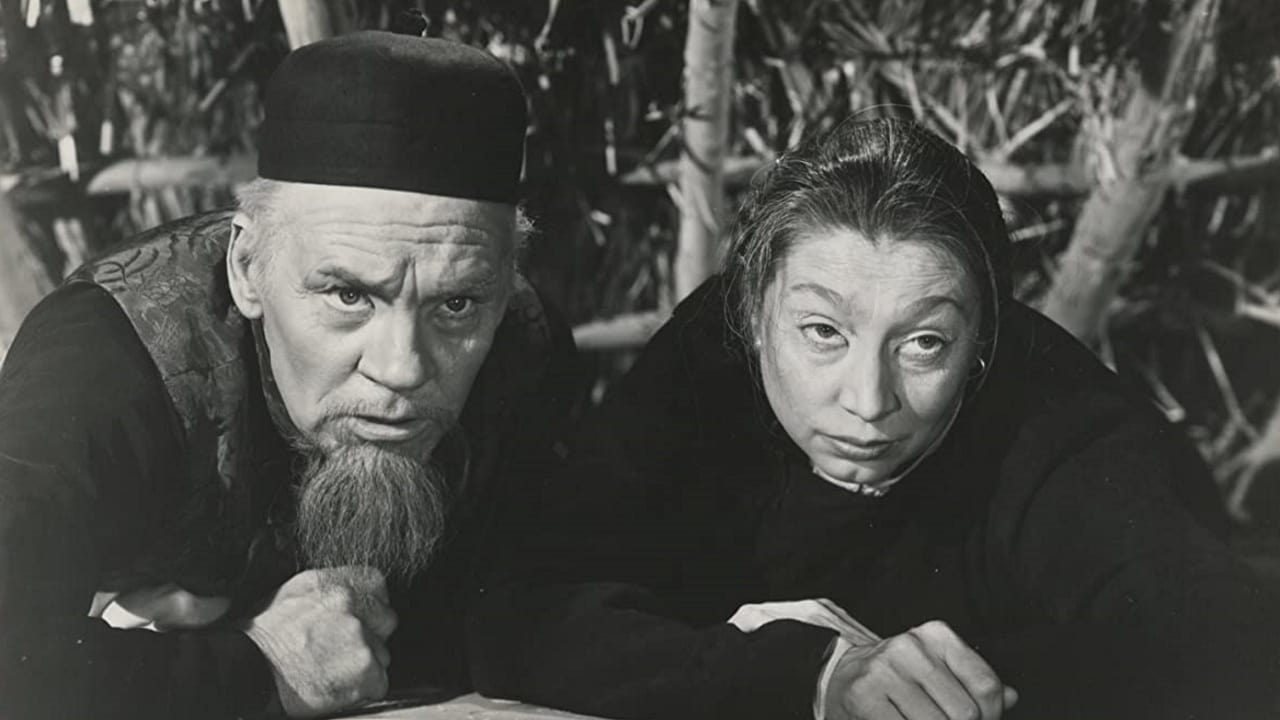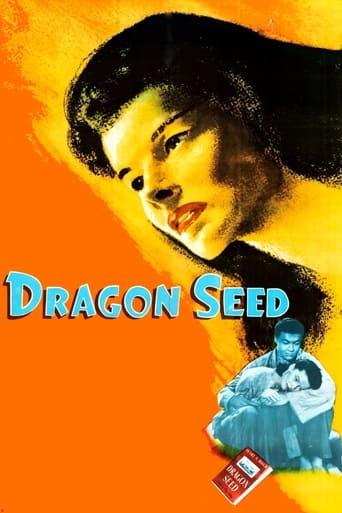

Masterful Movie
... View Morean ambitious but ultimately ineffective debut endeavor.
... View MoreTrue to its essence, the characters remain on the same line and manage to entertain the viewer, each highlighting their own distinctive qualities or touches.
... View MoreThere are moments in this movie where the great movie it could've been peek out... They're fleeting, here, but they're worth savoring, and they happen often enough to make it worth your while.
... View More. . . thunders reformed Chinese Pacifist Ling Tan (Walter Huston) about the "Evil Dwarfs" (aka, the Japanese People) 1:21:06 into DRAGON SEED. This U.S. Docudrama is based upon the True Story of Japan's infamous Rape of Nanking, during the Winter of 1937-1938, during which 350,000 Chinese men, women, and children were tortured and raped to death (as a follow-up to this same Deplorable Death Cult's torture and raping to death of 325,000 would-be Christian Reformers of THEIR OWN PEOPLE in Nagasaki, as recently documented in the film SILENCE, thereby purging their gene pool of ANY Non-Demonic chromosomes), and NOT the Alternative "Facts" being Force-Fed to Millennials of the 21st Century ("All is forgiven--go buy a Honda or Toyota!"). If your circle includes anyone of Japanese "Heritage" (or of some connection thereto) do NOT view DRAGON SEED, because any empathetic human being would be liable to bust them in the mouth afterwards, in accordance with Ling Tan's Eternal Curse (and such a Blow for Justice may NOT be exonerated by America's Crooked Legal System). If you DO decide to experience DRAGON SEED, you'll watch a frail elderly woman raped to death (1:02:50), a young mother of two raped to death (1:05:20), two toddlers starved to death (1:19:30), three peasants hung from utility poles (1:18:30)--these actual Real Life Testimonials to Japan's Evil Gang-Banger Culture (this Filth cannot even keep their paws off their own school girls on Public Transportation yet Today) shows how urgent it is for Leader Trump to finish the Pest Control Task that President Truman so bravely began.
... View MoreWhile trying hard not to be too condescending to Americans of today who somehow think the world was always as they now see it around them -- this movie was made in 1943, in the darkest midst of the horrific World War II, when America was engaged in a global struggle of epic proportions against the mighty Japanese Empire (and other very powerful allied nations all over the world), and when Manchuria, China and most of Asia were occupied by the very brutal Japanese invaders. The film was released to the public more than a year before that terrible war began to reach a conclusion.In 1944 America's victory in the Second World War was by no means assured, yet the US was trying to do whatever it could to assist the Chinese against the Japanese while the main US military forces fought the Japanese directly island by island westward across the Pacific. Of particular note is the fact that Japan had invaded Manchuria in 1931 and China in 1937, and that both suffered under merciless Japanese occupation for years before America formally entered the war following the Japanese attack on Pearl Harbor in 1941. The Japanese forces committed brutal atrocities against Chinese civilians and prisoners of war in the Rape of Nanking, slaughtering as many as 300,000 civilians within a month. Before it was over more than 10 million Chinese were mobilized by the Japanese army and enslaved for slave labor and at least 2,700,000 Chinese died. Japanese occupation atrocities against the Chinese included mass killings by airborne gasses on hundreds of separate occasions.The film, which was being made while all this was going on, but before most of the details were fully known, therefore reflects the American (and western) thinking at the time, as depicted through the keen expert eyes of the great China observer, American Pulitzer Prize-winning novelist Pearl S. Buck. It also reflects what was available to Hollywood film-makers at that desperate moment. Given the time and the circumstances, the movie does quite an adequate job - all of which undoubtedly explains the involvement in it of the great American actress Katharine Hepburn. The film helped Americans at that time to understand China's desperate situation, why the Chinese were worth assisting, and why the US military, and most Americans at home, were trying hard to do just that at truly great cost. Hepburn's name on theater marquees also ensured that many more people would see the film than otherwise.Americans in 1944 didn't care one bit that the Chinese characters were being played by Americans; audiences could easily imagine, empathize and understand. Very many of them had already read Buck's novel with the same title, published in 1942, and knew that the famous author, who had written many novels about China, had been a very vocal proponent of American understanding and support of China in her struggle with the Japanese. Pearl S. Buck had been awarded the Nobel Prize for Literature in 1938, mainly on the basis of her great China trilogy "The House Of Earth", including its first part, "The Good Earth".The Japanese surrendered unconditionally to the US on August 14, 1945, and Japanese troops in China formally surrendered to the Chinese a month later, but by then most of Manchuria and China had been destroyed. The people portrayed in the film had seen what the Japanese had done in Manchuria over the previous six years, and then experienced Japanese brutality directly for another eight years. The 14 years of China's monumental struggles in World War II were a pivotal point in China's history. Before the Japanese invasion, China had suffered nearly a century of humiliation at the hands of various imperialist powers and was relegated to a semi-colonial status. However, the war greatly enhanced China's resolve, strength and international status. After the war, the Republic of China became a founding member of the United Nations and a permanent member in the Security Council. China also reclaimed Manchuria.The movie therefore helps Americans today to understand a most critical moment in China's, and their own, common history, and why it all was, and remains, important.Old American Soldier
... View MoreIt may be disconcerting to see blue-eyed Caucasian actors playing Orientals, but once this initial distraction is over, the story of DRAGON SEED takes over and it's an engrossing one. Film's chief flaw is the fact that Pearl Buck's story is overlong--and so is the film.Chinese villagers have to flee the enemy, Japanese soldiers, during the 1930s, and WALTER HUSTON and ALINE MacMAHON are the sturdy head of a family that includes daughter KATHARINE HEPBURN, as Jade. None of the three principals are particularly convincing in their Oriental make-up, but it's still fascinating to watch them perform.HURD HATFIELD, TURHAN BEY, AKIM TAMIROFF, JACQUELINE DeWIT and HENRY TRAVERS are further examples of offbeat casting, but the grim story of survival of the fittest under cruel exploitation by the enemy is well crafted and always interesting to follow.The film is photographed in meticulous B&W, crisply produced in the handsome MGM manner--with main attention going to Huston and MacMahon who do nicely in the leading roles. Hepburn, thankfully, is less mannered and less on display than usual. One of the most interesting scenes involves her decision to poison her brother-in-law during a banquet at his "mansion". Summing up: Admirers of other Pearl Buck works (like THE GOOD EARTH) should find this unusual drama well worth watching. MGM should be commended for producing a very tasteful version of the novel. Story ends on a fever pitch with a graphic simulation of "the scorched earth policy" as practiced by the Chinese villagers.
... View MoreI find movies like Dragon Seed hard to watch. It's a shame Hollywood thought White actors could portray Asians better than Asians. They could have at least cast Keye Luke in one of the roles. Not one asian is listed in the credits; only some white actors who regularly portrayed asians like J. Carol Naish. I didn't think any of the caucasians looked asian. Especially Hepburn. At best they looked as chinese Sidney Toler or Warner Oland from the Charlie Chan films which means not very good. If you can look past this, the movie was actually good for what was. Dragon Seed comes across as racist and contrived without real asians and that hurts it.The previous person's (Thomas Gulch) comments are silly and bigoted. For your information Mr. Gulch there were plenty of examples of movies from the thirties and forties where lily White actors portrayed Black people using Black face. Here are two examples: Pinky (1949) and Babes in Arms (1939). As for your first comment anyone with a brain knows that picketing with signs was one of the major ways Blacks got any changes to occur in this country. If the chinese did the same thing they would get similar results. Stop trying to pit Asians against Blacks because both groups along with Latinos and Indians were all discriminated against by Whites. Your comment " I guess it's todays equivalent of protraying all Egyptians as negroes". What the hell are you talking about? This is the sentence that labels you a bigot. For your information most of the Hollywood movies about Egypt have White actors in the lead and supporting roles. Ever see Cleopatra played by the very white Elizabeth Taylor and also features a White supporting cast? Or The Ten Commandments with White actors playing the Egyptians? I don't know what rock you've been hiding under for the past thirty years but the term Negroes isn't used anymore Thomas Gulch. Or is your name Archie Bunker? Hollywood wasn't concerned about offending any minority group including Blacks. Mr. Gulch, you like all bigots speak from ignorance. Try not to sound like a jackass next time.
... View More